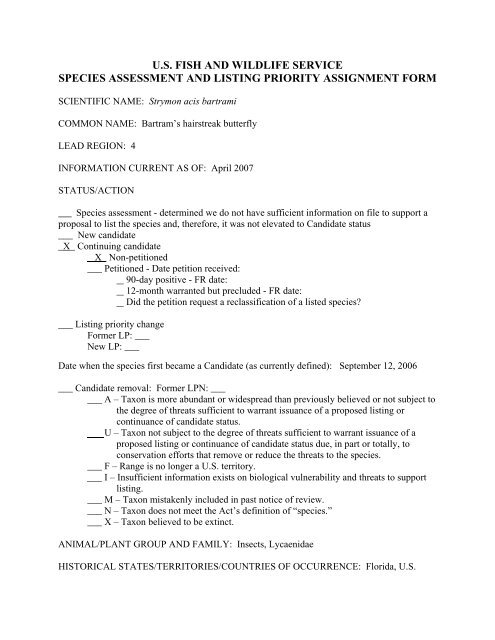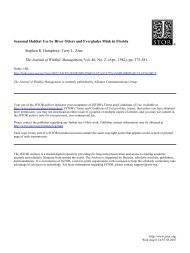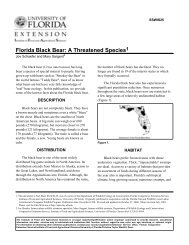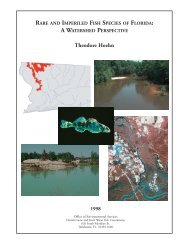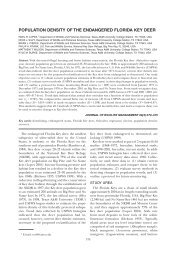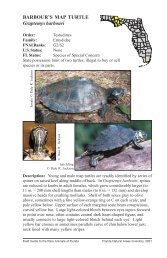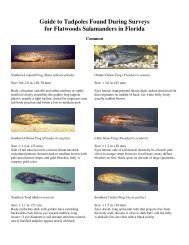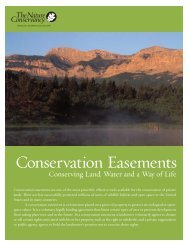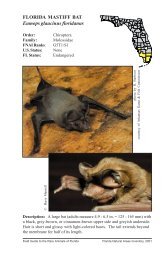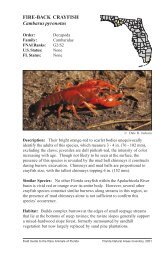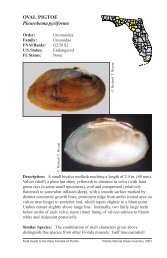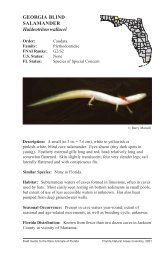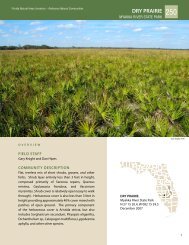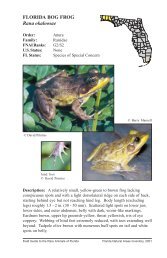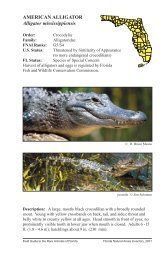Bartram's hairstreak butterfly - Florida Wildlife Conservation Guide
Bartram's hairstreak butterfly - Florida Wildlife Conservation Guide
Bartram's hairstreak butterfly - Florida Wildlife Conservation Guide
You also want an ePaper? Increase the reach of your titles
YUMPU automatically turns print PDFs into web optimized ePapers that Google loves.
U.S. FISH AND WILDLIFE SERVICE<br />
SPECIES ASSESSMENT AND LISTING PRIORITY ASSIGNMENT FORM<br />
SCIENTIFIC NAME: Strymon acis bartrami<br />
COMMON NAME: Bartram’s <strong>hairstreak</strong> <strong>butterfly</strong><br />
LEAD REGION: 4<br />
INFORMATION CURRENT AS OF: April 2007<br />
STATUS/ACTION<br />
Species assessment - determined we do not have sufficient information on file to support a<br />
proposal to list the species and, therefore, it was not elevated to Candidate status<br />
___ New candidate<br />
_X_ Continuing candidate<br />
_ X_ Non-petitioned<br />
___ Petitioned - Date petition received:<br />
90-day positive - FR date:<br />
12-month warranted but precluded - FR date:<br />
Did the petition request a reclassification of a listed species<br />
___ Listing priority change<br />
Former LP: ___<br />
New LP: ___<br />
Date when the species first became a Candidate (as currently defined): September 12, 2006<br />
___ Candidate removal: Former LPN: ___<br />
___ A – Taxon is more abundant or widespread than previously believed or not subject to<br />
the degree of threats sufficient to warrant issuance of a proposed listing or<br />
continuance of candidate status.<br />
U – Taxon not subject to the degree of threats sufficient to warrant issuance of a<br />
proposed listing or continuance of candidate status due, in part or totally, to<br />
conservation efforts that remove or reduce the threats to the species.<br />
___ F – Range is no longer a U.S. territory.<br />
I – Insufficient information exists on biological vulnerability and threats to support<br />
listing.<br />
___ M – Taxon mistakenly included in past notice of review.<br />
___ N – Taxon does not meet the Act’s definition of “species.”<br />
___ X – Taxon believed to be extinct.<br />
ANIMAL/PLANT GROUP AND FAMILY: Insects, Lycaenidae<br />
HISTORICAL STATES/TERRITORIES/COUNTRIES OF OCCURRENCE: <strong>Florida</strong>, U.S.
CURRENT STATES/COUNTIES/TERRITORIES/COUNTRIES OF OCCURRENCE: <strong>Florida</strong>,<br />
Monroe and Miami-Dade Counties, U.S.<br />
LAND OWNERSHIP: There are two populations of Bartram’s <strong>hairstreak</strong>, one on the mainland<br />
and one in the <strong>Florida</strong> Keys. The mainland population is within Long Pine Key in Everglades<br />
National Park (ENP). Total acreage including land and water of ENP in Miami-Dade, Monroe,<br />
and Collier Counties is 610,684 hectares [ha] (1,509,000 acres). In addition, sporadic and<br />
localized occurrences of Bartram’s <strong>hairstreak</strong> have been found within pine rockland fragments<br />
on lands owned by Miami-Dade County. Relict pine rocklands on other private lands may also<br />
provide suitable or potential habitat. In the <strong>Florida</strong> Keys, the <strong>butterfly</strong> occurs on Big Pine Key<br />
within National Key Deer Refuge (NKDR) and on private, State, and other lands (Salvato 1999;<br />
M. Salvato, Service, pers. comm. 2006). The NKDR is 3,723 ha (9,200 acres).<br />
LEAD REGION CONTACT: Cindy Bohn, 404-679-7122, Cynthia_Bohn@fws.gov<br />
LEAD FIELD OFFICE CONTACT: South <strong>Florida</strong> Ecological Services Office (SFESO), Paula<br />
Halupa, 772-562-3909 ext 257, paula_halupa@fws.gov<br />
BIOLOGICAL INFORMATION<br />
Species Description: The Bartram’s <strong>hairstreak</strong> is a small <strong>butterfly</strong> approximately 1 inch (in) (25<br />
millimeters [mm]) in length with a forewing length of 0.4 to 0.5 in (10 to 12.5 mm) and has an<br />
appearance characteristic of the genus (Comstock and Huntington 1943, Pyle 1981, Opler and<br />
Krizek 1984, Minno and Emmel 1993). Despite its rapid flight, this <strong>hairstreak</strong> is easily observed<br />
if present at any density as it alights often, and the brilliance of its grey underside marked with<br />
bold white postdiscal lines beneath both wings provides an instant flash of color against the<br />
foliage of its hostplant, pineland croton (Croton linearis) (Euphorbiaceae) (Smith et al. 1994,<br />
Salvato 1999). The Bartram’s <strong>hairstreak</strong> does not exhibit sexual or seasonal dimorphism.<br />
Eggs are laid singly on the flowering racemes of the hostplant, pineland croton (Salvato 1999).<br />
First and second instars remain well camouflaged amongst the white croton flowers, while the<br />
later stages roam the entire plant. Salvato and Hennessey (2004) reported approximate body<br />
lengths 2, 4, 6, and 11 mm for Bartram’s <strong>hairstreak</strong> 2 nd through 5 th instar larvae, respectively.<br />
Taxonomy: The Bartram’s <strong>hairstreak</strong> <strong>butterfly</strong>, Strymon acis bartrami, was first described by<br />
Comstock and Huntington in 1943 (Comstock and Huntington 1943). The Bartram’s <strong>hairstreak</strong><br />
is one of seven subspecies of Strymon acis (Smith et al. 1994). Smith et al. (1994) indicate that<br />
perhaps no other <strong>butterfly</strong> in the West Indies has evolved as many distinct island subspecies as S.<br />
acis. Each group of Antillean islands appears to have its own particular set of S. acis <strong>hairstreak</strong>s,<br />
and these have been classified into two separate groups. The Type A subspecies are larger,<br />
darker colored and are found in the more southeastern Antillean islands. The Type B subspecies,<br />
to which the Bartram’s <strong>hairstreak</strong> belongs, are smaller, more surface-grey colored. The<br />
Bartram’s <strong>hairstreak</strong> is endemic to <strong>Florida</strong> and occurs nowhere else in the world.<br />
We have carefully reviewed the available taxonomic information on the Bartram’s <strong>hairstreak</strong>
(Comstock and Huntington 1943, Smith et al. 1994, Worth et al. 1996, Salvato and Hennessey<br />
2004) and have reached the conclusion that S. acis bartrami is a valid taxon and an entity that<br />
could be listed pursuant to the Endangered Species Act (ESA).<br />
Habitat/Life History: Pineland croton, a subtropical species of Antillean origin, is the only<br />
known host plant for Bartram’s <strong>hairstreak</strong> (Opler and Krizek 1984, Schwartz 1987, Minno and<br />
Emmel 1993, Smith et al. 1994). Therefore, Bartram’s <strong>hairstreak</strong> is restricted to pine rocklands<br />
that contain pineland croton.<br />
Once occurring throughout the pine rocklands of the lower <strong>Florida</strong> Keys (Dickson 1955, Folk<br />
1991, Hennessey and Habeck 1991, Salvato 1999), pineland croton now occurs only on Big Pine<br />
Key. The last reports of the hostplant from other keys were from No Name in 1992 (Carlson et<br />
al. 1993) and from Little Pine (Folk 1991). Recent surveys of relict pineland throughout the<br />
lower keys by Salvato (1999, pers. comm. 2006) failed to locate the plant from any island other<br />
than Big Pine. Hennessey and Habeck (1991) and Salvato (1999) estimated that approximately<br />
80 ha (198 acres) of appropriate hostplant-bearing pine rockland habitat occur within NKDR.<br />
Another 1,068 ha (2,639 acres) of pine rockland habitat with appropriate hostplant occur within<br />
ENP (Hennessey and Habeck 1991, Salvato 1999).<br />
<strong>Bartram's</strong> <strong>hairstreak</strong> has been observed during every month on Big Pine Key and ENP; however<br />
the exact number of broods appears to be sporadic from year to year (Salvato and Hennessey<br />
2004). Baggett (1982) indicated that <strong>Bartram's</strong> <strong>hairstreak</strong> seemed most abundant in October-<br />
December. Salvato (1999) recorded 92 adult <strong>Bartram's</strong> <strong>hairstreak</strong> on Big Pine Key during a oneweek<br />
period in July 1997, suggesting the species can occur in high numbers throughout the year<br />
if suitable habitat and conditions are present (M. Salvato, pers. comm. 2006).<br />
Females oviposit on the flowering racemes of pineland croton (Salvato and Hennessey 2004).<br />
Eggs are laid singly on the developing raceme. Hennessey and Habeck (1991) observed a female<br />
oviposit three eggs over the course of five minutes. This long duration likely enables females to<br />
serve as one of the major pollinating species for the hostplant (Salvato 1999, 2003). First and<br />
second instars remain well camouflaged amongst the white croton flowers, while the later stages<br />
roam the entire plant.<br />
The <strong>Bartram's</strong> <strong>hairstreak</strong> is most often observed visiting pineland croton flowers for nectar, but<br />
has also been observed using the flowers of other species, including: pine acacia (Acacia<br />
pinetorum), Spanish needles (Bidens alba), saw palmetto (Serenoa repens), and buttonsage<br />
(Lantana involucrate) (Minno and Emmel 1993, Worth et al. 1996, Calhoun et al. 2002, Salvato<br />
and Hennessey 2004).<br />
Historical Range/Distribution: The Bartram’s <strong>hairstreak</strong> is endemic to south <strong>Florida</strong> and the<br />
lower <strong>Florida</strong> Keys. The other subspecies of Strymon acis occur throughout the West Indies<br />
(Smith et al. 1994).<br />
The Bartram’s <strong>hairstreak</strong> was once common within the widespread pine rockland habitat that<br />
occurred within Miami-Dade and Monroe Counties, less common and sporadic within Collier,<br />
Palm Beach, and Broward Counties (Baggett 1982, Smith et al. 1994, Salvato 1999, Salvato and
Hennessey 2004). Historically, pine rockland habitat covered 65,450 ha (161,730 acres) within<br />
Miami-Dade County (Loope and Dunevitz 1981, Service 1999). However, development has<br />
removed and/or fragmented pine rocklands from the majority of the <strong>hairstreak</strong>’s former range on<br />
peninsular <strong>Florida</strong> and the lower Keys (Service 1999, Salvato 1999). The rapid loss of habitat<br />
and the resulting increased distance between substantial populations of hostplants in the<br />
remaining pine rocklands is the most likely cause for the species disappearance from the<br />
mainland and keys.<br />
Current Range/Distribution: Populations of Bartram’s <strong>hairstreak</strong> have become increasingly<br />
localized as pine rockland habitat has been lost or altered through anthropogenic activity<br />
(Baggett 1982; Hennessey and Habeck 1991; Schwarz et al. 1996; Salvato 1999, 2001, 2003).<br />
Long Pine Key contains the largest remaining coverage of pine rockland habitat (8,029 ha<br />
[19,831 acres]) on peninsular <strong>Florida</strong> (Salvato 1999, Service 1999, Salvato and Hennessey<br />
2004). However, Hennessey and Habeck (1991) and Salvato (1999) estimated that<br />
approximately 1,068 ha (2,638 acres) of appropriate hostplant-bearing pine rockland habitat<br />
occur within Long Pine Key (all within ENP) for use by the Bartram’s <strong>hairstreak</strong>.<br />
In Miami-Dade County, outside of ENP, there are approximately 375 pine rockland fragments<br />
remaining totaling approximately 1,780 ha (4,398 acres) (Department of Environmental<br />
Resource Management 1995). Several of these fragments, particularly ones that are adjacent to<br />
ENP, such as Navy Wells Pineland Preserve and Camp Owaissa Bauer Hammock, appear to<br />
maintain small, localized populations of pineland croton as well as sporadic occurrences of<br />
Bartram’s <strong>hairstreak</strong> (Salvato 1999, 2003; Salvato and Hennessey 2004; M. Salvato, pers. comm.<br />
2006). A GIS analysis conducted by the Service using 2004 data indicates that 65 pine rockland<br />
fragments containing pineland croton remain in private ownership in Miami-Dade County<br />
totaling approximately 190 ha (470 acres) (The Institute for Regional <strong>Conservation</strong> [IRC]<br />
unpublished data). Another 12 fragments totaling 180 ha (446 acres) contain croton and are in<br />
public ownership (IRC unpublished data). The more recent analysis likely under-represents<br />
Bartram’s <strong>hairstreak</strong> habitat because it only involved areas where access was allowed.<br />
In the lower keys, Big Pine Key retains the largest undisturbed tracts of pine rockland habitat<br />
totaling an estimated 701 ha (1,732 acres) (Folk 1991, Hennessey and Habeck 1991, Salvato and<br />
Hennessey 2004). Although relict pine rocklands can still be found on several other islands<br />
within NKDR, only Big Pine Key maintains pineland croton (Salvato 1999; Salvato and<br />
Hennessey 2003, 2004). As a result, the Bartram’s <strong>hairstreak</strong> is present only on Big Pine Key.<br />
Hennessey and Habeck (1991) and Salvato (1999) estimated that approximately 80 ha (198<br />
acres) of appropriate hostplant-bearing pine rockland habitat occur within NKDR.<br />
Population Estimates/Status: Based on the results of historic (Baggett 1982, Schwartz 1987,<br />
Hennessey and Habeck 1991, Worth et al. 1996, Schwarz et al. 1996) and recent (Salvato 1999,<br />
2001, 2003; Salvato and Hennessey 2004; M. Salvato, pers. comm. 2006) surveys and natural<br />
history studies for this species, there are two populations of Bartram’s <strong>hairstreak</strong>. Surveys of<br />
Bartram’s <strong>hairstreak</strong> by Hennessey and Habeck (1991) and Salvato (1999, 2001) indicated that<br />
this <strong>butterfly</strong> was either locally common or rare in many pine rockland locations on Big Pine<br />
Key and sporadic in Long Pine Key for the duration of their respective studies. Hennessey and<br />
Habeck (1991) reported an estimate of 3.9 and 1 adult Bartram’s <strong>hairstreak</strong>s per ha (1.6 and 0.4
per acre) during 1988-1989 from survey transects on Big Pine Key and Long Pine Key,<br />
respectively. During 1997-1998, Salvato (1999) recorded an estimated 4.3 adult butterflies per<br />
ha (1.7 per acre) at survey transects across NKDR. However, Salvato (1999, 2001) failed to find<br />
stable numbers in either the Watson’s Hammock portion of NKDR or in Long Pine Key. The<br />
lower densities in Watson’s Hammock and Long Pine Key reported by Salvato (1999, 2001,<br />
pers. comm. 2006) and Salvato and Hennessey (2004) during the late 1980s and 1990s have been<br />
attributed to a lack of the adequate prescribed fires necessary in the pine rockland habitat to<br />
maintain appropriate levels of hostplants. As of early 2007, Salvato (pers. comm. 2007)<br />
recorded an average of 2.7 to 12.4 adults per ha (1.1 to 4.9 per acre) at transects across NKDR<br />
from 1997-2007.<br />
Salvato (1999, 2003) noted that the Bartram’s <strong>hairstreak</strong> had either been extirpated or greatly<br />
reduced across the majority of Long Pine Key at the time of his 1997-1998 studies. However,<br />
due in large part to an effective and systematic burn plan, Salvato (pers. comm. 2007) estimates<br />
the area now has maintained an average of 2 adults per ha (0.8 per acre) at Gate 4 from 1999-<br />
2007. Despite extensive monitoring, Salvato (pers. comm. 2007) only sporadically observes the<br />
species within pine rockland areas adjacent to ENP, such as Navy Wells. Salvato (pers. comm.<br />
2007) estimated that the population collectively at Big Pine Key, Long Pine Key, and within<br />
relict pine rocklands adjacent to ENP may range from roughly 100–800 adults.<br />
M. Minno (Eco-Cognizant, Inc., pers. comm. 2007) reports that <strong>Bartram's</strong> <strong>hairstreak</strong> occurs on<br />
Big Pine Key, at Navy Wells Preserve, and in ENP, but it is not common. Minno (pers. comm.<br />
2007) reports observing
The pine rockland community of southern <strong>Florida</strong> is globally endangered. Destruction of the<br />
pinelands for economic development has reduced this community by 90% on mainland south<br />
<strong>Florida</strong> (O’Brien 1996) and to 918 ha (2,268 acres) in the lower keys (Ross et al. 1994). The<br />
threat of habitat loss of remaining unprotected pine rocklands continues. Pine rockland<br />
fragments outside of ENP contain pineland croton and provide occupied and unoccupied<br />
habitat for the Bartram’s <strong>hairstreak</strong>. In particular, sites such as Navy Wells Pineland<br />
Preserve and Camp Owaissa Bauer Hammock appear to maintain small, localized<br />
populations of pineland croton and sporadic occurrences of Bartram’s <strong>hairstreak</strong> (Salvato<br />
1999, 2003; Salvato and Hennessey 2004; M. Salvato, pers. comm. 2007). A recent GIS<br />
analysis for Miami-Dade County indicates that 65 pine rockland fragments containing croton<br />
remain in private ownership, totaling approximately 190 ha (470 acres) (IRC unpublished<br />
data). Plans to develop public lands adjacent to the Miami Metro Zoo for a waterpark are<br />
underway. This development will curtail management of adjacent pine rocklands (K.<br />
Bradley, pers. comm. 2007) and cause habitat modification of areas which currently support<br />
sporadic occurrences of Bartram’s <strong>hairstreak</strong> (M. Salvato, pers. comm. 2007). In short,<br />
sporadic occurrences of Bartram’s <strong>hairstreak</strong> occurring on unprotected lands remain<br />
threatened by habitat destruction or modification.<br />
Similarly, while NKDR retains the largest undisturbed tracts of pine rockland habitat in the<br />
lower keys, other areas on Big Pine Key containing occupied and suitable habitat for the<br />
Bartram’s <strong>hairstreak</strong> remain unprotected. Therefore, habitat for Bartram’s <strong>hairstreak</strong> outside<br />
of NKDR boundaries remains at risk. Residential and commercial development has<br />
degraded essential components of Bartram’s <strong>hairstreak</strong> habitat and continues to pose a threat<br />
to remaining habitat.<br />
The threat of habitat destruction or modification is further exacerbated by lack of prescribed<br />
fire and suppression of natural fires. Natural fires are an important part of maintaining an<br />
ecosystem’s gradual succession and are important in maintaining the herbaceous layer of<br />
pine rocklands of which pineland croton is a part (Loope and Dunevitz 1981, Carlson et al.<br />
1993, Olson and Platt 1995, Bergh and Wisby 1996, Platt et al. 2000). In pine rockland<br />
habitat, frequent fires in the dry season burn back the overgrowth of the herbaceous layer,<br />
allowing native shrubs to re-sprout from secondary roots under the slash pine canopy. Resprouting<br />
after burns is the primary mechanism allowing for the persistence of perennial<br />
shrubs in pine habitat (Olson and Pratt 1995). Without fire, successional climax from<br />
tropical pineland to hardwood hammock is rapid and displacement of native species by<br />
invasive exotic plants often occurs. However, due to the proximity of remaining pine<br />
rockland habitat to urban areas much of these natural fires have been suppressed, often<br />
replaced by inconsistent regimes of managed or prescribed fires. The conversion of pine<br />
rockland into hardwood hammock is continuing on northeastern Big Pine, No Name, and<br />
Little Pine Keys. Pineland croton is now absent from these locations.<br />
Prescribed fire is used throughout the pine rocklands of Long Pine Key and has been<br />
consistently used for the past 50 years (Loope and Dunevitz 1981, Salvato 1999).<br />
Historically, however, when prescribed burns were conducted in Long Pine Key, the majority<br />
of the pine rockland habitat was burned in its entirety. This pattern of burning likely forced<br />
populations of Bartram’s <strong>hairstreak</strong> to the fringes of Long Pine Key, fragmenting the species’
distribution. Because the Bartram’s <strong>hairstreak</strong> is rarely encountered more than 5 m (16.4<br />
feet) from the hostplant (Worth et al. 1996), is it believed that the historic large-scale burns<br />
of Long Pine Key most often eradicated <strong>hairstreak</strong>s at the burn site (Salvato 1999).<br />
Since 1989, prescribed fires at Long Pine Key have been conducted every 2-3 years to mimic<br />
natural fire regimes historically ignited by lightening strikes (Robertson 1953, Slocum et al.<br />
2003, Salvato and Hennessey 2004). Although this has resulted in restoration of species-rich,<br />
herbaceous-dominated pine rocklands in many areas, including resurgence of pineland<br />
croton, the populations of croton remain fragmented. This is a concern for Bartram’s<br />
<strong>hairstreak</strong> because the species is relatively sedentary, generally not straying far from its host<br />
plant.<br />
Since 2001, prescribed fire in FMU 3, a fire management unit in Long Pine Key, has been<br />
planned on a landscape scale versus unit scale (National Park Service [NPS] 2005). Current<br />
fire management practices at Long Pine Key use partial and systematic prescribed burns and<br />
are conducted in a way that burns nearly all of the pine rocklands over a three-year window.<br />
Consequently, Salvato (pers. comm. 2006) has found that Bartram’s <strong>hairstreak</strong> has returned<br />
to Gate 4 and elsewhere in Long Pine Key. Fire management in Long Pine Key attempts to<br />
burn adjacent pine rockland habitats alternately. Although not specifically managed for any<br />
single species, the practice allows both a corridor for the butterflies to traverse at the time of<br />
the burn and provides nearby refugia for them to remain within while the burned site<br />
regenerates. Bartram’s <strong>hairstreak</strong>s are then provided an easier route back to the recently<br />
burned adjacent area which aides in faster re-colonization. Ideally, and historically, during<br />
this three-year interval, the butterflies will move from the burned location to adjacent refugia<br />
and then back to burned area in numbers equal to or greater than before the fire. The effects<br />
of this new burn technique were not immediately obvious when this plan took effect, but<br />
starting in the fall of 2004 and continuing into early 2006, the <strong>hairstreak</strong> appeared to have<br />
greatly benefited with population densities greater than those recorded in any of the previous<br />
studies (M. Salvato, pers. comm. 2007).<br />
The NPS acknowledges that endangered and threatened species and their habitats are the<br />
principle natural values at risk within FMU 3 (NPS 2005). ENP is working on incorporating<br />
considerations for life histories of select <strong>butterfly</strong> species into its management, but there may<br />
be some inconsistencies between implementation of the plan and meeting the needs for select<br />
species. For example, low numbers of butterflies in the pinelands are partially attributed to<br />
burning too soon following hurricanes and flooding and before host plants were fully<br />
recovered, as well as other factors (S. Perry, NPS, pers. comm. 2007). In May 2005, select<br />
portions of Long Pine Key were prescribed burned, but resurgence of vegetation within these<br />
burned areas was set back due to storm damage caused by Hurricanes Katrina and Wilma<br />
later that year (M. Salvato, pers. comm. 2007). By mid-2006, these areas had not recovered,<br />
yet burns adjacent to these areas continued, removing available host plants (M. Salvato, pers.<br />
comm. 2007). Although management in ENP in recent years has greatly benefited the<br />
Bartram’s <strong>hairstreak</strong>, adaptive management needs to be implemented during instances where<br />
recovery of recently burned areas is slowed. If future management activities are not carefully<br />
conducted, populations of this <strong>butterfly</strong> could be depressed further (S. Perry, pers. comm.<br />
2007; M. Salvato, pers. comm. 2007).
The objectives of the current NKDR fire management program are to: (1) protect human life,<br />
property, and other resources from unwanted fire and (2) restore and maintain biological<br />
diversity using fire as a viable ecological process (Service 2000). The latter includes<br />
maintaining biological diversity in fire-maintained plant communities by prescribed fire and<br />
also controlled natural fire under Service guidelines and maintaining habitat for trust<br />
resources, including endangered and threatened plant and animal species, especially the Key<br />
deer, through prescribed fire and controlled natural fire (Service 2000). The fire<br />
management plan for NKDR mentions Bartram’s <strong>hairstreak</strong> and its reliance on its firedependent<br />
host plant and indicates that “Concern has been raised that fire suppression is<br />
contributing to the decline of these species as the host plant requires a fire maintained open<br />
pineland to persist (Emmel et al. 1995).” However, no specific details are provided to<br />
enhance habitat or avoid / mitigate impacts to Bartram’s <strong>hairstreak</strong>. In addition, management<br />
of pine rocklands by NKDR is made particularly difficult by the pattern of land ownership<br />
and development; private homes and light commercial uses are embedded within or in close<br />
proximity to pineland habitat (Service 2000).<br />
Salvato (1999) indicated that burns are not being administered as thoroughly in Watson’s<br />
Hammock of NKDR as is needed to prevent loss of pine rocklands. As a result, much of the<br />
pine rocklands within northern Watson’s Hammock are being compromised by hardwood<br />
hammock (Salvato and Hennessey 2004). In addition, fire breaks leading into Watson’s<br />
Hammock have been expanded; these expansions included cutting back and removing large<br />
quantities of native vegetation, including croton (M. Salvato, pers. comm. 2007). Although<br />
the current burn plan within NKDR appears favorable for some <strong>butterfly</strong> species with strong<br />
flight abilities, it is not favorable for the relatively sedentary Bartram’s <strong>hairstreak</strong>. Without<br />
an appropriate hostplant-laden corridor between the area to be burned and an area of refugia<br />
for the <strong>hairstreak</strong>s to congregate within safely during the burns, the species ultimately<br />
disappears (Salvato and Hennessey 2004). Therefore, fire and fire management continues to<br />
be a threat for Bartram’s <strong>hairstreak</strong> at NKDR and surrounding lands on Big Pine Key.<br />
In summary, despite substantial habitat losses, the threat of habitat of destruction or<br />
modification of remaining unprotected pine rocklands continues today. Sporadic occurrences<br />
of the <strong>butterfly</strong> and suitable habitat on unprotected pine rocklands outside of ENP and NKDR<br />
largely remain at risk to development. Habitat loss, fire suppression, and lack of fire<br />
management in the past have led to the current fragmentation and degradation of remaining<br />
habitat. The threat of destruction, modification, or curtailment of habitat due to wildfire and<br />
fire management appears to have been lessened on ENP but continues on NKDR and<br />
surrounding private lands. Additional habitat loss could result in a significant further<br />
reduction in the range of this species.<br />
B. Overutilization for commercial, recreational, scientific, or educational purposes.<br />
Rare butterflies and moths are highly prized by collectors and an international trade exists in<br />
specimens for both live and decorative markets, as well as the specialist trade that supplies<br />
hobbyists, collectors, and researchers (Morris et al. 1991, Williams 1996). The specialist<br />
trade differs from both the live and decorative market in that it concentrates on rare and<br />
threatened species (U.S. Department of Justice 1993). In general, the rarer the species, the
more valuable it is, and prices may exceed U.S. $2,000 for rare specimens (Morris et al.<br />
1991).<br />
We do not have direct evidence of collection of Bartram’s <strong>hairstreak</strong>. Historically, this<br />
species has been highly sought after by collectors. It is unlikely that collecting or the threat<br />
of collection has ceased. Salvato (pers. comm. 2006) has not seen specimens of the<br />
Bartram’s <strong>hairstreak</strong> listed by the wholesale and specialty insect dealers who offer and sell<br />
butterflies to museums, artists, and collectors. However, Salvato (pers. comm. 2006) has<br />
been contacted by numerous individuals requesting specimens of the Bartram’s <strong>hairstreak</strong> or<br />
in regard to locations where they may be collected in the field. Thus, there is an established<br />
desire for specimens.<br />
Bartram’s <strong>hairstreak</strong> occurrence largely on protected Federal lands may help protect it from<br />
collectors. In the past, when this species was more widespread on Big Pine Key and<br />
throughout southern Miami-Dade County, collecting likely exhibited little pressure on this<br />
species. At present, even limited collection from the small populations in NKDR or ENP<br />
could have deleterious effects on the Bartram’s <strong>hairstreak</strong> reproductive and genetic viability<br />
and thus could contribute to its eventual extinction. Illegal collection could occur in ENP or<br />
NKDR without being detected since these areas are not actively patrolled. Similarly, in some<br />
areas such as Navy Wells, there is no signage indicating collection is prohibited.<br />
Consequently, the potential for unauthorized or illegal collection of eggs, larvae, pupae,<br />
and/or adults exists and could go undetected, despite the protection provided on Federal or<br />
other public lands.<br />
In summary, we have no direct evidence that collection of Bartram’s <strong>hairstreak</strong> is occurring<br />
at present. However, the established interest in specimens and information requests<br />
regarding its location on the part of collectors, researchers, and others suggests that collection<br />
may be occurring and has the potential to occur at any time. At present, we do not have an<br />
adequate basis to conclude that the species is currently threatened by overutilization for<br />
commercial, recreational, scientific, or educational purposes. However, because there are<br />
only two small populations remaining, we believe that collection has the potential to be a<br />
serious threat to the species at any time.<br />
C. Disease or predation.<br />
Hennessey and Habeck (1991) collected a fifth-instar larva of Bartram’s <strong>hairstreak</strong> on Big<br />
Pine Key from which during pupation a single braconid wasp was produced. This is the only<br />
known record for a parasitoid towards this species. Tracking the fate of Bartram’s <strong>hairstreak</strong><br />
pupae is extremely difficult because it pupates in the ground litter (Worth et al. 1996).<br />
Collection of other late instar Bartram’s <strong>hairstreak</strong> larvae is needed to determine the<br />
influence of parasitism on its early stages (Salvato and Hennessey 2004).<br />
Crab spiders (Aranea: Thomisidae) are frequently observed during surveys for Bartram’s<br />
<strong>hairstreak</strong>s on pineland croton and are likely a major predator of adult and larvae (Salvato<br />
and Hennessey 2004, M. Salvato, pers. comm. 2006). Salvato (pers. comm. 2006) has<br />
observed dragonflies (Odonata) taking adult Bartram’s <strong>hairstreak</strong>s within Long Pine Key.<br />
Various birds and lizards are also likely natural predators. Although there are several natural
predators, we do not know to what extent predation is a threat to Bartram’s <strong>hairstreak</strong> at this<br />
time. We do not have evidence that predation is unusually high or above levels to be<br />
expected in nature. Based upon information available, we do not consider this species to be<br />
threatened by disease or predation at this time.<br />
D. The inadequacy of existing regulatory mechanisms.<br />
This species is not listed in the State of <strong>Florida</strong>. Federal, State, and local laws have not been<br />
sufficient to prevent past and ongoing impacts to Bartram’s <strong>hairstreak</strong> or its habitat.<br />
For scientific research on and/or collection of Bartram’s <strong>hairstreak</strong> at ENP and/or NKDR, a<br />
permit is required from the NPS or the Service, respectively. Although Bartram’s <strong>hairstreak</strong><br />
occurs on Federal land which offers protection, these areas are vast and open to the public.<br />
Public lands can be heavily used, with signage prohibiting collection often lacking and<br />
patrolling / monitoring of activities largely absent. Therefore, potential illegal collection<br />
could occur without being detected. Since Bartram’s <strong>hairstreak</strong> is not listed by the State, it is<br />
not protected from being killed and from unauthorized take if encountered outside of NKDR<br />
or ENP. Consequently, the potential for unauthorized or illegal collection of Bartram’s<br />
<strong>hairstreak</strong> (eggs, larvae, pupae, or adults) exists, as discussed under Factor B above and could<br />
go undetected, despite its occurrence on Federal lands.<br />
The 1979 Master Plan is the plan of record for ENP, however the NPS is currently preparing<br />
a new General Management Plan for ENP, which is still two to three years from completion<br />
(F. Herling, NPS, pers. comm. 2006). The current plan for ENP indicates one goal as<br />
“Natural and cultural resources and associated values are protected, restored and maintained<br />
in good condition and managed within their broader ecosystem and cultural context.”<br />
However, the Master Plan is not regulatory and its implementation is not mandatory.<br />
Similarly, the Comprehensive <strong>Conservation</strong> Plan is the principal guiding document for<br />
National <strong>Wildlife</strong> Refuges and the Service is in the process of developing one for NKDR.<br />
Although still in the development phase, this plan will likely focus on management of natural<br />
communities, Service trust resources, and threatened and endangered species. It is unknown<br />
to what degree the plan will address the needs of other imperiled species or the extent to<br />
which NKDR will have the resources necessary to meet its management needs.<br />
At this time, the protection currently afforded Bartram’s <strong>hairstreak</strong> is limited, provides little<br />
protection to the species’ occupied habitat, and includes no protection of unoccupied habitat.<br />
Current management plans for Federal lands do not specifically address Bartram’s <strong>hairstreak</strong><br />
and land management practices do not currently incorporate specific life history needs for<br />
this species. Therefore, we conclude that the existing regulatory mechanisms are inadequate<br />
to protect Bartram’s <strong>hairstreak</strong> and its habitat.<br />
E. Other natural or manmade factors affecting its continued existence.<br />
As the amount of human activity and size of the human population has increased in south<br />
<strong>Florida</strong>, so has the control of salt marsh mosquitoes (Aedes sollicitans (Walker) and A.<br />
taeniorhynchus (Wiedemann)). To suppress mosquitoes, second-generation<br />
organophosphates (naled) and pyrethroid (permethrin) adulticides are used year-round
throughout south <strong>Florida</strong> and from May to November in the Keys by mosquito control<br />
districts (Hennessey et al. 1992, Salvato 1999). Malathion is used elsewhere in the State, but<br />
it has not been used by the <strong>Florida</strong> Keys Mosquito Control District (FKMCD) since 1994<br />
(Hribar and Fussell 2005; L. Hribar, FKMCD, pers. comm. 2006). It is the FKMCD’s policy<br />
to conduct source reduction before larviciding, and larviciding before adulticiding (Hribar<br />
and Fussell 2005). Despite the improved mosquito control practices, the use of adulticides<br />
applied using both aerial and ground-based methods to control mosquitoes presents collateral<br />
effects on non-target species.<br />
The lethal effect of second-generation organophosphate pesticides, such as naled and<br />
fenthion, on non-target Lepidoptera was well noted initially in south <strong>Florida</strong> and the Keys,<br />
with the decline of the endangered Schaus swallowtail <strong>butterfly</strong> (Papilio aristodemus<br />
ponceanus) (Emmel and Tucker 1991, Eliazar 1992). This species’ dramatic decline in the<br />
early 1970s coincided with the expanded use of chemical pesticides by the Monroe County<br />
Mosquito Control District (MCMCD), now known as the FKMCD, on the northern Keys<br />
(Emmel and Tucker 1991, Eliazar 1992). When spraying was halted during two periods<br />
(1987 and 1989-1992), the species began to recover. The swallowtail’s immediate decline<br />
when applications resumed clearly suggested the adverse effect chemical pesticides have on<br />
non-target species. Studies conducted by Hennessey et al. (1992) illustrated the presence of<br />
spray residue long after application in the habitat of the Schaus swallowtail and several other<br />
imperiled butterflies. Baggett (1982) also suggested that the rapid decline in several<br />
populations of butterflies in the Keys was directly attributable to mosquito control pesticide<br />
applications.<br />
Eliazar (1992) conducted intensive testing on the effects of the chemical pesticides naled and<br />
fenthion on several south <strong>Florida</strong> <strong>butterfly</strong> species. His results indicated that chemical<br />
pesticides and their field application rates, particularly those of naled, were extremely toxic<br />
to non-target Lepidoptera and were being administered in the field at levels above the dosage<br />
required to kill target Aedes mosquitoes. Eliazar’s naled experiments, conducted in the<br />
laboratory, included several <strong>butterfly</strong> species (not Bartram’s <strong>hairstreak</strong>) likely to be found in<br />
the lower Keys, including the giant swallowtail (Papilio cresphontes), the zebra <strong>butterfly</strong><br />
(Heliconius charitonia), the gulf fritillary (Agraulis vanillae), and the painted lady (Vanessa<br />
cardui). Based upon Eliazar’s (1992) results and similar studies, we believe that naled or<br />
fenthion used at field application rates would also have lethal or at least sublethal effects on<br />
Bartram’s <strong>hairstreak</strong>.<br />
In addition, Salvato (1999, 2001) measured the toxicity of naled and permethrin on a number<br />
of surrogate species and these adulticides were highly toxic towards these butterflies in both<br />
immature and adult stages. Furthermore, Salvato (1999, 2001, pers. comm. 2006) has been<br />
monitoring populations of Bartram’s <strong>hairstreak</strong> on survey transects within NKDR since 1997<br />
and has indicated that numbers of <strong>hairstreak</strong>s encountered across the island is likely only a<br />
fraction of what might occur were adulticide applications restricted or limited within NKDR<br />
lands. According to Salvato (1999, 2001, pers. comm. 2006), the species’ tendency to<br />
congregate in large densities on croton flowers along pine rockland clearings and roadsides<br />
on Big Pine Key makes the Bartram’s <strong>hairstreak</strong> far more susceptible than other butterflies to<br />
both aerial and truck applied adulticide applications.
Spraying practices by the FKMCD at NKDR have changed to reduce pesticide use over the<br />
years. According to the Special Use Permit issued by the Service, the number of aerially<br />
applied naled treatments allowed on NKDR has been reduced to a specified allotment (i.e., 9<br />
per mosquito season, no closer than 5 days apart [R. Frakes, Service, pers. comm. 2006]).<br />
These changes were made after the Service reviewed the toxicity of naled on federally listed<br />
species that occur within NKDR; however, this analysis did not include species of<br />
Lepidoptera, since none on NKDR are listed. Since insects are more sensitive to<br />
organophosphates than the vertebrate species considered in the analysis, negative impacts to<br />
Bartram’s <strong>hairstreak</strong> and other Lepidoptera from continued naled applications will likely<br />
occur, despite the reduced use of this insecticide. The Service plans to use information from<br />
pesticide studies that are currently underway (see <strong>Conservation</strong> Measures) to more fully<br />
analyze effects to listed species and candidate species on federal lands.<br />
The small outlying areas of NKDR have been designated no-spray zones by agreement<br />
between the Service and MCMCD. Essentially all of the pine rocklands within NKDR<br />
except Watson’s Hammock on Big Pine Key are sprayed with naled (aerially applied<br />
adulticide); additionally, residential areas and roadsides across Big Pine Key are treated with<br />
permethrin (ground-based applied adulticide) (Salvato 1999). In short, basically all areas of<br />
Big Pine Key, except Watson’s Hammock and Cactus Hammock, are sprayed with naled or<br />
permethrin. Therefore, Bartram’s <strong>hairstreak</strong> and its occupied and suitable habitat on Big<br />
Pine Key are directly exposed to adulticides used for mosquito control.<br />
Designation of no-spray zones does not mean a lack of chemical intrusion. When these<br />
zones were created in 1989, pesticide drift downwind into them had not been documented.<br />
However, Hennessey et al. (1992) detected naled residues 750 m (2,460 feet) into the nospray<br />
zone at Watson’s Hammock and 150 m (492 feet) at Cactus Hammock. Truck-applied<br />
ultra-low-volume (ULV) fenthion, sprayed primarily in residential areas, did not appear to<br />
drift into non-target areas. This study indicated that naled remained in the habitat well into<br />
midday, posing risk to diurnally active non-target species, such as Bartram’s <strong>hairstreak</strong>. In a<br />
more recent study by <strong>Florida</strong> A&M University involving the candidate Miami blue <strong>butterfly</strong><br />
(Cyclargus thomasi bethunebakeri) in north Key Largo, substantial amounts of drift have<br />
also been reported. Preliminary results of that study have demonstrated drift up to four miles<br />
from the application site; however, it is not yet known if adverse impacts occur at the residue<br />
level detected at that distance from the application zone (T. Bargar, Service, pers. comm.<br />
2007). Therefore, Bartram’s <strong>hairstreak</strong>s utilizing Watson’s Hammock are exposed to<br />
chemical residues despite its location within a no-spray zone.<br />
During his ongoing survey, Salvato (1999, 2001, pers. comm. 2006) has not found<br />
significantly larger densities of Bartram’s <strong>hairstreak</strong> within the unsprayed Watson’s<br />
Hammock area of NKDR, as he has for other <strong>butterfly</strong> species. Salvato attributes this to a<br />
lack of adequate fire management in this part of NKDR. Salvato believes that fragmentation<br />
of host plant within Watson’s Hammock has resulted in reduced numbers of Bartram’s<br />
<strong>hairstreak</strong> in this area compared to elsewhere on Big Pine Key where croton grows more<br />
continuously (M. Salvato, pers. comm. 2006).
In general Long Pine Key does not appear to be regularly impacted by mosquito control<br />
practices, except for the use of adulticides in residential areas and campgrounds. Housing<br />
areas, maintenance areas, outside work areas for park maintenance staff and contractors, and<br />
areas near buildings are sprayed (S. Perry, pers. comm. 2007). In addition, there are reports<br />
that operators frequently leave the foggers on when traveling from one area to another within<br />
ENP (S. Perry, pers. comm. 2007). Spraying is widespread following hurricanes (S. Perry,<br />
pers. comm. 2007). Other sporadic Bartram’s <strong>hairstreak</strong> populations adjacent to and outside<br />
ENP and other suitable and potential habitat within Miami-Dade County are vulnerable to the<br />
lethal and sublethal effects of adulticide applications.<br />
Butterflies in south <strong>Florida</strong> and the Keys, such as Bartram’s <strong>hairstreak</strong>, have adapted over<br />
time to the influence of tropical storms and other forms of adverse weather conditions (M.<br />
Salvato, pers. comm. 2006). However, given the substantial reduction in the Bartram’s<br />
<strong>hairstreak</strong>’s historic range in the past 50 years, the threat and impact of tropical storms and<br />
hurricanes on the remaining populations is much greater than when its distribution was more<br />
widespread. The active hurricane season of 2005 resulted in extensive damages to pine<br />
rockland habitats both within NKDR and ENP. In October 2005, Watson’s Hammock within<br />
NKDR was heavily damaged from Hurricane Wilma. Native vegetation across much of<br />
Watson’s Hammock, including croton, has not recovered. The <strong>Bartram's</strong> <strong>hairstreak</strong> has not<br />
been observed in Watson’s Hammock since the storm. Loss of hostplant has likely prevented<br />
any potential resurgence for the species recovery in areas such as Watson’s Hammock.<br />
According to the National Oceanographic and Atmospheric Administration, Miami-Dade<br />
County, the Keys, and western Cuba are the most storm-prone areas in the Caribbean so this<br />
threat is expected to continue.<br />
The Bartram’s <strong>hairstreak</strong> is vulnerable to extinction because its two populations are small<br />
and isolated. A population of 1,000 has been suggested as marginally viable for an insect,<br />
although this is likely highly dependent upon type of species (D. Schweitzer, The Nature<br />
Conservancy, pers. comm. 2003). Schweitzer (pers. comm. 2003) has also suggested that<br />
<strong>butterfly</strong> populations of less than 200 adults per generation would have difficulty surviving<br />
over the long-term. Therefore, the Bartram’s <strong>hairstreak</strong> population at Big Pine Key<br />
(estimated at 160 – 500) appears to be at risk.<br />
In general, isolation, whether caused by geographic distance, ecological factors, or<br />
reproductive strategy, will likely prevent the influx of new genetic material and can result in<br />
a highly inbred population with low viability and/or fecundity (Chesser 1983). Natural<br />
fluctuations in rainfall, hostplant vigor, or predation may weaken a population to such an<br />
extent that recovery to a viable level would be impossible. Isolation of habitat can prevent<br />
recolonization from other sites and result in extinction. The Bartram’s <strong>hairstreak</strong> is largely<br />
restricted to two locations, one occurring within pine rocklands of Big Pine Key, a second<br />
within Long Pine Key. Distance between these populations and the small size of highly<br />
sporadic populations make recolonization unlikely if populations are extirpated.<br />
Fragmentation of habitat and the limited dispersal capabilities of this <strong>butterfly</strong> lead us to<br />
believe this species is vulnerable because of the small number of populations, their small<br />
size, and their relative isolation.
CONSERVATION MEASURES PLANNED OR IMPLEMENTED<br />
Fire management practices of pine rocklands within ENP and potentially NKDR may provide<br />
benefits for the Bartram’s <strong>hairstreak</strong>. The <strong>Florida</strong> Comprehensive <strong>Wildlife</strong> <strong>Conservation</strong><br />
Strategy discusses management of pine rocklands, but has not been implemented or funded<br />
(FWC 2005).<br />
The Service has funded a comprehensive laboratory study with <strong>Florida</strong> International University<br />
to refine knowledge of the toxicology and effects of naled and permethrin. Specific objectives of<br />
this study are to: (1) determine the toxicity of naled and permethrin to different stages of the life<br />
cycle of butterflies at environmentally relevant concentrations of insecticides and (2) conduct a<br />
probabilistic ecological risk assessment for butterflies by comparing species sensitivity<br />
distributions for naled, dichlorvos, and permethrin with exposure distributions for each<br />
insecticide at different sites. The Service has also provided funding to Mote Marine Laboratory<br />
to better estimate toxicological effects in the field. Specific objectives of this study are to: (1)<br />
determine mosquito adulticide distribution, concentrations, and persistence in the field following<br />
routine mosquito control operations and (2) provide empirical data from field studies for<br />
comparison with laboratory toxicity studies of mosquito adulticide effects on lepidopteran<br />
species. In addition, a Service representative participates in the field study currently underway in<br />
with <strong>Florida</strong> A&M University, which is testing the effects of adulticides on the Miami blue<br />
<strong>butterfly</strong>, including the amount of deposition and extent of drift. The Service will have a better<br />
understanding of the risk to its trust resources by some mosquito control practices following<br />
completion of these studies.<br />
SUMMARY OF THREATS<br />
The Bartram’s <strong>hairstreak</strong> and its habitat are vulnerable to a wide variety of natural and human<br />
factors. The two small, isolated populations and other sporadic and localized occurrences are<br />
exposed to extreme weather events (e.g., hurricanes). Mosquito control practices are a threat to<br />
the population on Big Pine Key, including NKDR. Habitat of the Bartram’s <strong>hairstreak</strong>, pine<br />
rocklands, is globally imperiled and dependent upon fire. Inappropriate fire management or<br />
wildfire could destroy the Bartram’s <strong>hairstreak</strong> and impact the availability of pineland croton, its<br />
sole host plant. Further reduction of the populations and associated localized occurrences,<br />
especially due to catastrophic weather, mosquito spraying, loss of suitable habitat, or<br />
inappropriate fire management could severely reduce the likelihood of this <strong>butterfly</strong>’s survival.<br />
Finally, the established interest in specimens of Bartram’s <strong>hairstreak</strong> and information requests<br />
regarding its location on the part of collectors, researchers, and others suggests that collection<br />
may be occurring and has the potential to occur at any time. At the present time, there is<br />
insufficient information to conclude that the species is currently threatened by overutilization for<br />
commercial, recreational, scientific, or educational purposes. We find that this species is<br />
warranted for listing throughout all its range, and, therefore, find that it is unnecessary to analyze<br />
whether it is threatened or endangered in a significant portion of its range.<br />
RECOMMENDED CONSERVATION MEASURES<br />
• Address concerns regarding impacts of mosquito control activities in relation to pine
ockland habitats on NKDR and adjacent properties. Establish additional no-spray zones<br />
and wider buffer areas around these zones.<br />
• Review and adjust fire management practices as needed to help maintain or expand the<br />
population size or numbers of populations. Coordinate activities among fire crews,<br />
biologists, and lepidopterists and use adaptive management as needed.<br />
• Protect remnant patches of pine rocklands and use prescribed fire to restore native plant<br />
diversity.<br />
• Restore pineland croton to relict fragments of pine rocklands within the species’ historic<br />
range to expand its occupied habitat.<br />
LISTING PRIORITY<br />
THREAT<br />
Magnitude Immediacy Taxonomy Priority<br />
High<br />
Imminent<br />
Non-imminent<br />
Monotypic genus<br />
Species<br />
Subspecies/population<br />
Monotypic genus<br />
Species<br />
Subspecies/population<br />
1<br />
2<br />
3*<br />
4<br />
5<br />
6<br />
Moderate<br />
to Low<br />
Imminent<br />
Non-imminent<br />
Monotypic genus<br />
Species<br />
Subspecies/population<br />
Monotypic genus<br />
Species<br />
Subspecies/population<br />
7<br />
8<br />
9<br />
10<br />
11<br />
12<br />
Rationale for listing priority number:<br />
Magnitude: The Bartram’s <strong>hairstreak</strong> is threatened by the combined influences of habitat<br />
destruction and modification from continued loss of unprotected pine rocklands and wildfire or<br />
fire management on protected sites. Mosquito control activities are a serious threat to the<br />
<strong>butterfly</strong> at NKDR, one of its two remaining populations, as well as anywhere the species occurs<br />
outside of ENP. Loss of genetic diversity may be a problem for the <strong>butterfly</strong> considering its<br />
small, fragmented, and isolated populations. The probability for catastrophic events (e.g.,<br />
hurricanes) and the possibility of accidental harm or habitat destruction are threats due to small<br />
population sizes / limited numbers at the few remaining locations. In addition to these threats,<br />
displacement of the hostplant by invasive exotic species and inadequate regulatory protection<br />
continue to pose threats to the species throughout its historic range. Overall, we find that these<br />
threats are of high magnitude. We also recognize that illegal collection is a potential threat to the<br />
species.<br />
Imminence: The threats of habitat destruction and modification are occurring with the continued
loss of unprotected pine rocklands and wildfire or fire management on protected sites. The<br />
Bartram’s <strong>hairstreak</strong> continues to be negatively impacted by adulticides used for mosquito<br />
control on Big Pine Key and outside of ENP. The threat from loss of genetic diversity within<br />
small, fragmented, and isolated populations is expected to continue. The likelihood of extreme<br />
weather or catastrophic events (e.g., hurricanes) to both remaining populations seriously<br />
threatens the survival of this <strong>butterfly</strong>, and these threats are expected to continue. We find these<br />
threats to be currently occurring and imminent. In addition, since there is an established interest<br />
in locations and desire for specimens by collectors, researchers, and others, we believe this<br />
species is at risk of collection and that this may be occurring and has the potential to occur<br />
unnoticed at any time, since areas where the species occurs are remote and open to the public.<br />
Rationale for Change in Listing Priority Number (insert if appropriate)<br />
Yes<br />
Have you promptly reviewed all of the information received regarding the species for the<br />
purpose of determining whether emergency listing is needed<br />
Is Emergency Listing Warranted No. Emergency listing is not warranted because there are two<br />
populations of Bartram’s <strong>hairstreak</strong> on Federal lands, with the population ranging from an<br />
estimated 100 to 800 adults. Since this <strong>butterfly</strong> is being regularly monitored, the Service should<br />
be aware of any further reduction in the number of populations, changes in size of a population,<br />
and degradation of habitat to undertake emergency listing in a timely manner, should it be<br />
necessary.<br />
DESCRIPTION OF MONITORING<br />
Surveys for Bartram’s <strong>hairstreak</strong> are ongoing. Monitoring began in 1997 and has been<br />
conducted either monthly or bi-monthly throughout the <strong>butterfly</strong>’s historic range (Salvato 1999,<br />
2001, pers. comm. 2007; Salvato and Hennessey 2004). In addition, Sue Perry (NPS) surveys<br />
for this species periodically within ENP.<br />
The SFESO sent previous versions of this form to FWC, NPS, and NKDR, requesting review<br />
and comments. The SFESO sent the Candidate Notice of Review (CNOR) to species experts,<br />
land managers, agencies, organizations, and other interested parties on September 12, 2006,<br />
when this species became a federal candidate. Only one individual, L. Hribar, provided<br />
comments and concerns and the Service provided a response on October 23, 2006. Information<br />
provided by Hribar was reviewed and considered during the revision of this assessment.<br />
The Service will continue to send updated forms to species experts, land managers,<br />
knowledgeable individuals, and interested parties. We believe this level of monitoring is<br />
adequate at this time to update the status of the species, considering that it is being actively<br />
monitored throughout its range by Salvato and within ENP by Perry.<br />
COORDINATION WITH STATES<br />
Indicate which State(s) (within the range of the species) provided information or comments on
the species or latest species assessment: None.<br />
Indicate which State(s) did not provide any information or comments: <strong>Florida</strong>. A previous<br />
version of this form was sent to FWC. No comments or additional information have been<br />
received to date. The Bartram’s <strong>hairstreak</strong> <strong>butterfly</strong> is included in the State’s <strong>Wildlife</strong> Action<br />
Plan, <strong>Florida</strong>’s Comprehensive <strong>Wildlife</strong> <strong>Conservation</strong> Strategy, and is on the list of species of<br />
greatest conservation need (FFWCC 2005).<br />
LITERATURE CITED<br />
2 Baggett, H.D. 1982. Order Lepidoptera. In R. Franz (ed.), Invertebrates. In P. C. Pritchard (ed.)<br />
Rare and Endangered Biota of <strong>Florida</strong>. Volume 6. Invertebrates, pages 78-81.<br />
University Press, Gainesville, <strong>Florida</strong>.<br />
3 Bergh, C., and J. Wisby. 1996. Fire history of the lower Keys pine rocklands. Nature<br />
Conservancy (publishers). Key West, <strong>Florida</strong> 38 pp.<br />
1 Calhoun, J.V., J.R. Slotten, and M.H. Salvato. 2002. Rise and fall of tropical blues in <strong>Florida</strong>:<br />
Cyclargus ammon and Cyclargus thomasi bethunebakeri (Lepidoptera: lycaenidae).<br />
Holarctic Lepidoptera 7(1):13-20.<br />
1 Carlson, P.C., G.W. Tanner, J.M. Wood, and S.R. Humphrey. 1993. Fires in Key deer habitat<br />
improves browse, prevents succession, and preserves endemic herbs. Journal of <strong>Wildlife</strong><br />
Management 57:914-928.<br />
1 Chesser, R.K. 1983. Isolation by distance: relationship to the management of genetic<br />
resources. Pages 66-77 in S. Schonewald-Cox, M. Chambers, B. MacBryde, and L.<br />
Thomas (eds), Genetics in conservation: a reference for managing wild animal and plant<br />
populations. The Benjamin/Cummings Publishing Company, Inc.<br />
1 Comstock, W.P., and E.I. Huntington. 1943. Lycaenidae of the Antilles (Lepidoptera,<br />
Rhopalocera). Annals of the New York Academy of Sciences 45(2):49-130.<br />
3 Department of Environmental Resource Management. 1995. Restoration plan for Dade<br />
County’s pine rockland forests following Hurricane Andrew. Dade County Department<br />
Environmental Resource Management. Miami, <strong>Florida</strong>.<br />
3 Deyrup, M. and R. Franz (eds). 1994. Rare and Endangered Biota of <strong>Florida</strong>. Volume IV.<br />
Invertebrates. University Press of <strong>Florida</strong>, Gainesville, <strong>Florida</strong>.<br />
2 Dickson, J.D. 1955. An ecological study of the Key Deer. <strong>Florida</strong> Game and Freshwater Fish<br />
Commission. Pittmann-Robertson Project Technical Bulletin 3.<br />
1 Eliazar, J.E. 1992. Effect of two mosquito adulticides, naled and fenthion, on selected nontarget<br />
lepidopteran species. M.S. Thesis. University of <strong>Florida</strong>, Gainesville, <strong>Florida</strong>.
3 Emmel, T.C., and J.C. Tucker (eds). 1991. Mosquito control pesticides: ecological importance<br />
and management alternatives. Scientific Publishers, Inc. Gainesville, <strong>Florida</strong>.<br />
3 Emmel, T.C. R.A. Worth and K. Schwarz. 1995. The relationships between host plant and<br />
habitat for the distribution of three potentially endangered south <strong>Florida</strong> <strong>butterfly</strong><br />
species. Report to the National Biological Survey.<br />
3 <strong>Florida</strong> Fish and <strong>Wildlife</strong> <strong>Conservation</strong> Commission. 2005. <strong>Florida</strong>’s <strong>Wildlife</strong> Legacy<br />
Initiative. <strong>Florida</strong>’s Comprehensive <strong>Wildlife</strong> <strong>Conservation</strong> Strategy. Tallahassee, <strong>Florida</strong>.<br />
1 Folk, M.L. 1991. Habitat of the Key deer. Ph.D. Dissertation, Department of Zoology.<br />
Southern Illinois University, Carbondale, Illinois.<br />
3 Hennessey, M.K., and D.H. Habeck. 1991. Effects of mosquito adulticiding on populations of<br />
non-target, terrestrial arthropods in the <strong>Florida</strong> Keys. United States Department of<br />
Agriculture - Agricultural Research Service. Miami, <strong>Florida</strong>.<br />
1 Hennessey, M.K., H.N. Nigg, and D.H. Habeck. 1992. Mosquito (Diptera: Culicidae)<br />
adulticide drift into wildlife refuges of the <strong>Florida</strong> Keys. Environmental Entomology<br />
21(4):715-720.<br />
3 Hribar, L.J., and E.M. Fussell. 2005. Mosquito control, Miami blues, and mass media in<br />
Monroe County, <strong>Florida</strong>. Technical Bulletin of the <strong>Florida</strong> Mosquito Control Association<br />
Number 5. <strong>Florida</strong> Keys Mosquito Control District, Marathon, <strong>Florida</strong>.<br />
3 Loope, L.L., and V.L. Dunevitz. 1981. Impact of fire exclusion and invasion of Schinus<br />
terebinthifolius on limestone rockland pine forests of southeastern <strong>Florida</strong>. South <strong>Florida</strong><br />
Resource Center. Report T-645, National Park Service. Everglades National Park,<br />
Homestead, <strong>Florida</strong>.<br />
3 Minno, M.C., and T.C. Emmel. 1993. Butterflies of the <strong>Florida</strong> Keys. Scientific Publishers,<br />
Inc., Gainesville, <strong>Florida</strong>.<br />
2 Morris, M.G., N.M. Collins, R.T. Vane-Wright, and J. Waage. 1991. The utilization and value<br />
of non-domesticated insects. Pages 319-347 in Collins, N.M. and J.A. Thomas (eds), The<br />
<strong>Conservation</strong> of Insects and Their Habitats, Academic Press, London.<br />
4 National Park Service. 2005. Fire Management Plan for Everglades National Park (Park<br />
Review Draft). U.S. Department of the Interior, National Park Service. Everglades<br />
National Park, Homestead, <strong>Florida</strong>.<br />
3 NatureServe. 2006. NatureServe Explorer: an online encyclopedia of life [web application].<br />
Version 6.1. NatureServe, Arlington, Virginia. http://www.natureserve.org/explorer<br />
(Accessed March 7, 2007).
1 O’Brien, J.J. 1996. Habitat preferences of rare and common Galactia native to south <strong>Florida</strong><br />
pine rocklands. M.S. Thesis. <strong>Florida</strong> International University, Miami, <strong>Florida</strong>.<br />
1 Olson, M.S., and W.J. Platt. 1995. Effects of habitat and growing season fires on resprouting<br />
of shrubs in longleaf pine savannas. Vegetatio 119:101-118.<br />
3 Opler, P.A., and G.O. Krizek. 1984. Butterflies east of the Great Plains. The John Hopkins<br />
University Press, Baltimore, Maryland.<br />
1 Platt, W.J., R.F. Doren, and T. Armentano. 2000. Effects of Hurricane Andrew on stands of<br />
slash pine (Pinus elliottii var. densa) in the Everglades region of south <strong>Florida</strong> (USA).<br />
Plant Ecology 146:43-60.<br />
3 Pyle, R.M. 1981. The Audubon Society field guide to North American butterflies. Alfred A.<br />
Knopf, New York.<br />
3 Robertson, W.B. Jr. 1953. A survey of the effects of fire in Everglades National Park.<br />
Mimeographed Report, U.S. Department of the Interior. National Park Service, Atlanta,<br />
Georgia.<br />
2 Ross, M.S., J.J. O’Brien, and L.J. Flynn. 1994. Sea-level rise and the reduction of pine<br />
forests in the <strong>Florida</strong> Keys. Ecological Applications 4(1):144-156.<br />
1 Salvato, M.H. 1999. Factors influencing the declining populations of three <strong>butterfly</strong> species in<br />
South <strong>Florida</strong> and the lower <strong>Florida</strong> Keys. M.S. Thesis. University of <strong>Florida</strong>,<br />
Gainesville, <strong>Florida</strong>.<br />
1 Salvato, M.H. 2001. Influence of mosquito control chemicals on butterflies (Nymphalidae,<br />
Lycaenidae, Hesperidae) of the lower <strong>Florida</strong> Keys. Journal of the Lepidopterists'<br />
Society 55(1):8-14.<br />
1 Salvato, M.H. 2003. Butterfly conservation and host plant fluctuations: the relationship<br />
between Strymon acis bartrami and Anaea troglodyta floridalis on Croton linearis in<br />
<strong>Florida</strong> (Lepidoptera: Lycaenidae and Nymphalidae). Holarctic Lepidoptera 10(1-2):53-<br />
57.<br />
1 Salvato, M.H., and M.K. Hennessey. 2003. Notes on the Historic Range and Natural History of<br />
Anaea troglodyta floridalis. Journal of the Lepidopterists' Society 57(3):243-249.<br />
1 Salvato, M.H., and M.K. Hennessey. 2004. Notes on the status and fire-related ecology of<br />
Strymon acis bartrami. Journal of the Lepidopterists' Society 58(4):223-227.<br />
3 Schwartz, A. 1987. The butterflies of the Lower <strong>Florida</strong> Keys. Milwaukee Public Museum,<br />
Contributions in Biology and Geology 73:1-34.<br />
1 Schwarz, K.A., R.A. Worth, and T.C. Emmel. 1996. <strong>Conservation</strong> of two threatened south
<strong>Florida</strong> butterflies and their host plant (Lepidoptera: Lycaenidae, Nymphalidae).<br />
Holarctic Lepidoptera 3:59-61.<br />
1 Slocum, M.G., W.J. Platt, and H.C. Cooley. 2003. Effects of differences in prescribed fire<br />
regimes on patchiness and intensity of fires in subtropical savannas of Everglades<br />
National Park, <strong>Florida</strong>. Restoration Ecology 11:91-102.<br />
2 Smith, D.S., L.D. Miller, and J.Y. Miller. 1994. The Butterflies of the West Indies and South<br />
<strong>Florida</strong>. Oxford University Press, New York.<br />
5 U.S. Department of Justice. 1993. Press Release: Extensive seizures of federally protected<br />
wildlife. December 14, 1993. San Jose, California. 3 pp. and attachments.<br />
4 U.S. Fish and <strong>Wildlife</strong> Service. 1999. South <strong>Florida</strong> multi-species recovery plan. U.S. Fish<br />
and <strong>Wildlife</strong> Service, Atlanta, Georgia.<br />
4 U.S. Fish and <strong>Wildlife</strong> Service. 2000. Fire Management Plan, National Key Deer Refuge.<br />
U.S. Fish and <strong>Wildlife</strong> Service, Big Pine Key, <strong>Florida</strong>.<br />
5 Williams, T. 1996. The great <strong>butterfly</strong> bust. Audubon (March-April):30-37.<br />
1 Worth, R.A., K.A. Schwarz, and T.C. Emmel. 1996. Notes on the biology of Strymon acis<br />
bartrami and Anaea troglodyta floridalis in south <strong>Florida</strong>. Holarctic Lepidoptera 3(2):<br />
62-65.<br />
Key:<br />
1 Peer reviewed original research based on data<br />
2 Peer reviewed secondary research derived<br />
3 Grey research based on data<br />
4 Grey literature based on literature analysis<br />
5 Other
Appendix 1. Threats Assessment: Bartram’s <strong>hairstreak</strong> <strong>butterfly</strong>.<br />
A: Destruction, Modification, or<br />
Curtailment of Habitat<br />
Stressor Source Scope Immediacy Intensity Exposure Response<br />
urban, residential, and Moderate<br />
commercial development<br />
loss of pine rocklands, habitat<br />
degradation, habitat<br />
fragmentation<br />
Imminent,<br />
historic, and<br />
future<br />
High Moderate Basic need<br />
inhibited, reduction<br />
in survival and<br />
reproduction,<br />
abandonment of<br />
habitat, mortality<br />
Overall Threat<br />
Level<br />
High<br />
loss / removal of hostplant,<br />
conversion to hardwood<br />
hammock<br />
suppression of natural fire,<br />
lack of prescribed fire, use<br />
of prescribed fire before<br />
plant recovery (following<br />
hurricanes, flooding, or<br />
fire), invasive plants<br />
Moderate<br />
Imminent,<br />
historic, and<br />
future<br />
High<br />
Significant Basic need<br />
inhibited, reduction<br />
in survival and<br />
reproduction,<br />
abandonment of<br />
habitat, mortality<br />
High<br />
B: Overutilization for Commercial,<br />
Recreational, Scientific, or<br />
Educational Purposes<br />
collection<br />
collectors, researchers, Moderate<br />
other interested individuals<br />
Future,<br />
historic,<br />
imminent<br />
Low<br />
Very<br />
Significant<br />
Mortality<br />
Low<br />
C: Disease or Predation Not applicable - no current<br />
threat exists<br />
D: Inadequacy of Existing<br />
Regulatory Mechanisms<br />
no substantive protection of<br />
occupied or suitable habitat<br />
NA NA NA NA NA NA NA<br />
inadequate regulations Moderate Imminent,<br />
historic, and<br />
future<br />
High<br />
Significant Basic need<br />
inhibited, reduction<br />
in survival and<br />
reproduction,<br />
abandonment of<br />
habitat, mortality<br />
Moderate<br />
E: Other Natural or Man-made<br />
Factors<br />
toxicity of pesticides mosquito control pesticides Moderate Imminent,<br />
historic, and<br />
future<br />
High<br />
Significant Basic need<br />
inhibited, reduction<br />
in survival and<br />
reproduction,<br />
mortality<br />
High
loss of hostplant hurricanes, tropical storms, Moderate<br />
flooding<br />
Imminent,<br />
historic, and<br />
future<br />
Moderate<br />
Very<br />
Significant<br />
Basic need<br />
inhibited, reduction<br />
in survival and<br />
reproduction,<br />
mortality<br />
Moderate<br />
genetic drift, inbreeding, loss<br />
of genetic variability, random<br />
or chance changes to<br />
environment<br />
small population size,<br />
isolated locations<br />
Moderate<br />
Future,<br />
unknown<br />
Unknown Unknown Reduction in<br />
viability<br />
Unknown
APPROVAL/CONCURRENCE: Lead Regions must obtain written concurrence from all other<br />
Regions within the range of the species before recommending changes, including elevations or<br />
removals from candidate status and listing priority changes; the Regional Director must approve<br />
all such recommendations. The Director must concur on all resubmitted 12-month petition<br />
findings, additions or removal of species from candidate status, and listing priority changes.<br />
Approve: June 11, 2007<br />
for Regional Director, Fish and <strong>Wildlife</strong> Service Date<br />
Concur:<br />
Director, Fish and <strong>Wildlife</strong> Service<br />
Date<br />
Do not concur:<br />
Director, Fish and <strong>Wildlife</strong> Service<br />
Date<br />
Director's Remarks:<br />
Date of annual review: March 11, 2007; revised April 26, 2007<br />
Conducted by: Paula Halupa, South <strong>Florida</strong> Ecological Services Office


